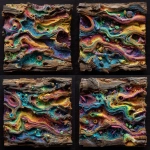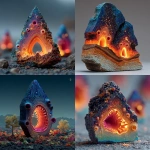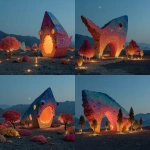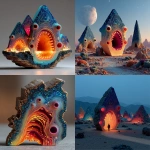Explore the Best AI Image Gallery

Beyond the Canvas: How VR and AR are Transforming Gaming and the Creative Industry
The lines between reality and virtuality are blurring as virtual reality (VR) and augmented reality (AR) technologies reshape the gaming landscape. These immersive experiences are not only captivating players but also revolutionizing the creative industry, offering unprecedented opportunities for artists, designers, and developers to push boundaries and explore new frontiers.
From crafting hyperrealistic game worlds to enabling interactive storytelling, VR and AR are redefining how we create and consume content. This exploration delves into the transformative power of these technologies, highlighting their potential uses, ethical considerations, and future trends within gaming and beyond.
A Playground for Creativity: Immersive Game Development
VR and AR offer game developers a playground of possibilities, allowing them to craft immersive worlds that transcend traditional gameplay. Imagine stepping into a fantastical realm, wielding magical spells, or exploring alien landscapes – all from the comfort of your own home. VR enables complete immersion, transporting players into the heart of the action, while AR overlays digital elements onto the real world, enriching our existing environment with interactive experiences.
- Hyperrealistic Environments: VR technology allows developers to create incredibly detailed and realistic game worlds. Every brick, blade of grass, and character model can be meticulously crafted, immersing players in a believable virtual environment.
- Enhanced Interactivity: Players can interact with their surroundings in new and intuitive ways using motion controllers or hand tracking. This level of interactivity creates a more engaging and responsive gameplay experience.
- Storytelling Revolution: AR and VR offer unique opportunities for storytelling. Imagine experiencing a narrative through the eyes of a character, making choices that directly impact the storys outcome. These technologies can blur the lines between observer and participant, creating truly immersive and unforgettable experiences.
Beyond Gaming: Expanding Creative Horizons
The potential applications of VR and AR extend far beyond gaming. These technologies are poised to revolutionize various creative industries:
- Film and Television: Immersive storytelling in VR allows audiences to step into the heart of a film or television show, experiencing events from multiple perspectives.
- Architecture and Design: Architects and designers can use VR to create virtual walkthroughs of buildings, allowing clients to visualize their projects before construction begins.
- Education and Training: Immersive learning experiences in VR can bring theoretical concepts to life, enhancing comprehension and engagement.
- Art and Performance: Artists can explore new forms of expression using VR and AR, creating interactive installations and performances that blur the lines between reality and imagination.
Navigating Ethical Considerations
As with any powerful technology, ethical considerations must be carefully addressed when implementing VR and AR.
- Data Privacy: The collection and use of user data in immersive experiences raise concerns about privacy. Its crucial to establish clear guidelines and ensure user consent for data collection and usage.
- Virtual Addiction: The highly engaging nature of VR and AR could lead to excessive use and potential addiction. Striking a balance between immersive experiences and real-world interactions is essential.
- Representation and Bias: The content created within virtual environments should reflect diversity and inclusivity, avoiding harmful stereotypes and biases that perpetuate societal inequalities.
Looking Ahead: Future Trends in VR and AR
The future of VR and AR holds immense promise. Advancements in technology will continue to push the boundaries of what is possible:
- Enhanced Realism: Continued advancements in graphics processing and haptic feedback will create even more realistic and immersive virtual environments.
- Wider Accessibility: As technology becomes more affordable and accessible, VR and AR will reach a wider audience, democratizing creative opportunities.
- Seamless Integration: VR and AR experiences will become increasingly integrated into our daily lives, blurring the lines between the digital and physical worlds.
- New Applications: The potential applications of VR and AR are constantly expanding, with new and innovative uses emerging across various industries.
As we venture deeper into this immersive future, its crucial to embrace the transformative power of VR and AR while navigating ethical considerations responsibly. These technologies have the potential to reshape not only the gaming industry but also the very fabric of our creative landscape, unlocking new realms of imagination and innovation.



](https://images.ai-img.art/thumbnails/150/ebc95932b25c17607076ed8d2a4bafc85c3371cf3f2d45c35741505fe3c97de1.webp)
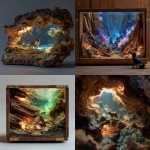



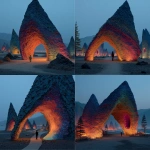


](https://images.ai-img.art/thumbnails/150/98325fa7102e81df81f1dba6df8df52929b4fa41b058192faf3c77cf94513ff7.webp)
](https://images.ai-img.art/thumbnails/150/914cb18c03c97bdba2f290c0ec1573d5792bf399dbad7f484614764eb31f4c2f.webp)
](https://images.ai-img.art/thumbnails/150/7d9de60c58579b921ad140a9e1d752642452d5086b74a27d866e8af04608ed7d.webp)


](https://images.ai-img.art/thumbnails/150/a31f622763ce0ecb2e76a907e566b81cfcc171e8d9b8b393f27681be24b6ca91.webp)





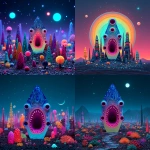

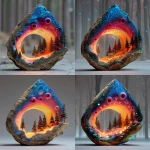
](https://images.ai-img.art/thumbnails/150/09314c003088f7174f747fa65105eca599e0842cf69e637ce4c98ebefd3f50ab.webp)




](https://images.ai-img.art/thumbnails/150/ac7218edd6198d49ed8d9853a5890595fc4d2a7a11c2e8a7ee8bcfbc7bfe265e.webp)




](https://images.ai-img.art/thumbnails/150/769518185300fcbda91b7bbf92b9007bc856379accd52eaf7983f9aec379e88e.webp)



](https://images.ai-img.art/thumbnails/150/3b65287fef447a6ad61bcb18b5b9d03b6f6f74603ae0e058f81f4b91a3e02f36.webp)





